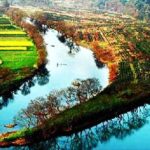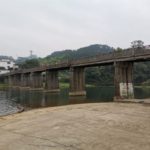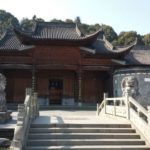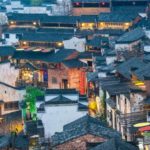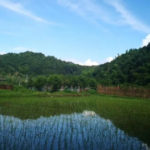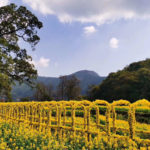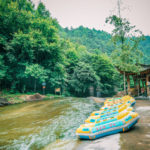East Route
The most popular route. East Tour Route features beautiful ancient villages. In Spring, Jiangling village and Huangling village are the top spots to enjoy the spectacular views of terraced fields of canola flowers and take memorable pictures of this unique natural scenery. Cycle or walk around the small villages, and spend a night in the countryside inns, you will feel relaxed and refreshed with the enchanting rural scenery.
Moon Bay → Likeng Village → Wangkou Village → Jiangwan Village → Huangling Village → Xiaoqi Village → Jiangling Village → Qingyuan→ Wulongyuan Rafting
shaped like a crescent moon, Moon Bay is a roadside attraction on the way to Likeng. The gorgeous views in the light of the early morning sunrise or late afternoon sunset make it a must-stop for photography lovers.
Characterized by the river running through the village, Likeng is a quaint waterside village with Huizhou-style houses lining the riverbank and pretty stone bridges spanning both sides. Well-developed and easily accessible, Likeng is a very popular destination with tourists.
Wangko was first developed in Song Dynasty, it was an important commercial wharf at the time in Wuyuan. There are still some well preserved ancient official halls, ancient merchants residences, and regular ancient villagers’ homes in the village. Among them, the Yu Ancestral Hall is the most famous with impressive and exquisite wood carvings throughout the whole structure.
Jiangwan is surrounded by three sides of rolling mountains, an S-shaped river runs east to west through the village, a traditional setup for an ancient village. This area is full of cultural heritage and has produced numerous well-known scholars and important officials in history. Well-preserved ancestral halls and official mansions are dotted in this village, Xiaojiang Ancestral Hall is the highlight of the all.
Perched on top of a hill, Huangling is home to a host of original and restored Huizhou-style houses and buildings. Huangling also has a spectacular view of the blooming canola fields in the spring and it puts on a colorful harvest display every autumn – making Huangling an architecture lover’s delight and a photographer’s paradise.
Consists of Upper Xiaoqi and Lower Xiaoqi. The two villages are connected by a 500 meter ancient stone path, which is a very pleasant walk with views of canola flowers in the spring, and lotus flowers in the summer. Xiaoqi is a village that has distinctive historic and cultural influences in Wuyuan’s history with some well-preserved Ming and Qing-era Hui Style houses. Xiaoqi is well known for its ecological environment, it allows ancient trees to grow and rare birds like Panda birds to build homes here. Its tea culture, from the process of tea production to tea workshops and tea displays, also attracts many tea lovers to visit.
Featuring immense terraces cascading from the hilltop to the bottom of the valley, and the breathtaking bright golden sea of canola flowers stretching to the horizon, Jiangling is the postcard countryside at its most enchanting. It is the top choice for visitors to view the amazing canola flower bloom in Spring.
Wulongyuan is situated in the highest original ecological forest in Wuyun. The area is surrounded by ancient trees and various plantations. The water is natural, crystal clear to the bottom. In summer, it is where you get yourself cool, and it is designed to get your heart pumping and ensure you don’t leave dry, definitely an exciting activity for the young and the young at heart.
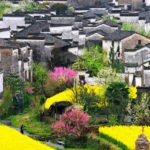
Qingyuan Village
Qingyuan is a small, quaint rural village tucked away on East Route. In spring, yellow canola flowers, pink peach flowers, and white pear flowers are dotted with ancient houses, making it a very pretty village to visit.

